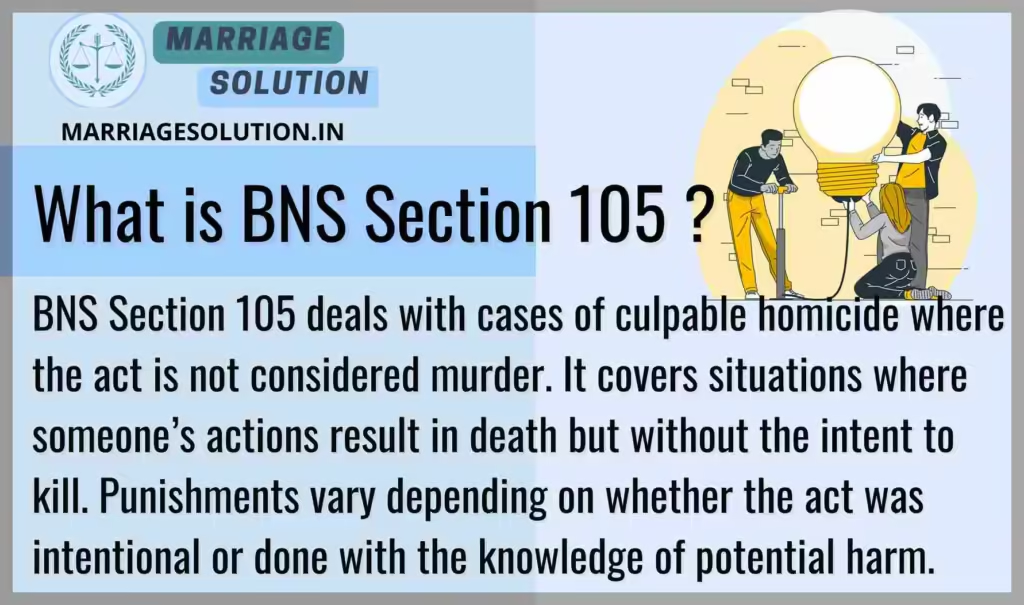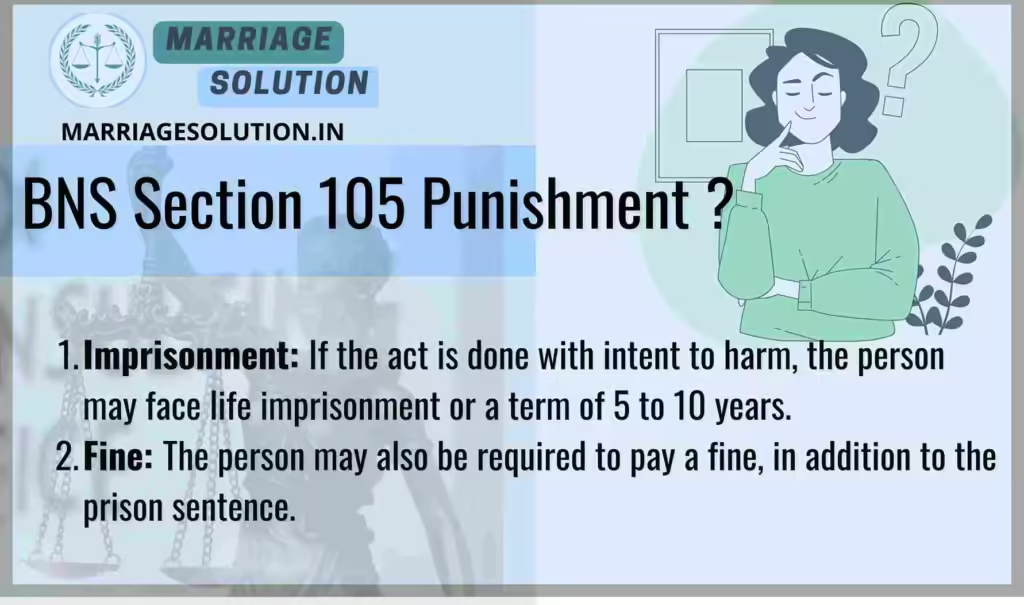Introduction of Section 105 BNS
Not all deaths are treated as murder in criminal law. When someone causes a death without intending to kill—but knowing their actions could be lethal—that’s ‘culpable homicide not amounting to murder’. Section 105 of the BNS ensures fair and proportionate punishment for such acts, balancing justice with intent.
The Bharatiya Nyaya Sanhita (BNS) 105 replaces the old Indian Penal Code (IPC) Section 304.
What is BNS Section105 ?
BNS Section 105 deals with cases of culpable homicide where the act is not considered murder. It covers situations where someone’s actions result in death but without the intent to kill. Punishments vary depending on whether the act was intentional or done with the knowledge of potential harm.

BNS Act 105
Whoever commits culpable homicide not amounting to murder shall be punished with imprisonment for life, or imprisonment for a term not less than five years but which may extend to ten years, and shall also be liable to fine.
This section applies to cases where a person’s actions cause death, but the act is not considered murder. The difference lies in intent and knowledge:
- If the act was done with the intention to kill or cause serious injury likely to cause death, the punishment is life imprisonment or rigorous imprisonment up to 10 years, plus a fine.
- If the act was done without direct intent but with knowledge that death was likely, the punishment is still strict — 5 to 10 years of imprisonment plus a fine.
In simple words, this law ensures that even if a killing does not qualify as “murder,” it is still treated as a grave crime.
Key Elements of the BNS Act
- Culpable Homicide – The act must result in death but fall short of murder due to absence of full intent.
- Intent vs Knowledge –
- Intent to kill → Life imprisonment or 10 years + fine.
- Knowledge only → 5–10 years + fine.
- Not Murder – The case does not meet the stricter definition of murder under Section 103.
- Grave Offense – Still considered a serious offense under criminal law.
- Fine in Addition – Besides imprisonment, a fine is always applicable.
Examples to Understand BNS Act
Example 1 (Intent – Severe Punishment):
Ravi strikes Mohan on the head with an iron rod, intending to cause serious harm. Mohan dies from the injury.
This is culpable homicide not amounting to murder. Ravi may face life imprisonment or 10 years + fine.
Example 2 (Knowledge – Lesser Punishment):
Chetan throws a heavy stone into a crowd, knowing it could cause death but without intending to kill anyone. A person dies. Chetan acted with knowledge but no intent. He may face 5–10 years of imprisonment + fine.
Example 3 (Not Applicable – Pure Accident):
Arjun is driving carefully when a sudden landslide pushes his car into pedestrians, causing death. This is not culpable homicide under Section 105, as there was no intent or knowledge. It may fall under negligence provisions instead.
Why this BNS Act is Important
- Balances Justice – It punishes killers but recognizes the difference between murder and lesser forms of homicide.
- Protects Human Life – Shows that every life lost due to wrongful acts must be addressed under law.
- Clear Distinction – Separates cases of murder (Section 103) from culpable homicide not amounting to murder (Section 105).
- Proportional Punishment – Ensures that punishment matches the offender’s mental state (mens rea) — whether intent or just knowledge.
- Modernized Language – Replaces IPC Section 304 with simpler, more accessible wording.
Section 105 BNS Overview
Section 105 of the Bharatiya Nyaya Sanhita (BNS) defines the punishment for culpable homicide that falls short of being classified as murder. This includes acts where death is caused either with the intent to kill or with knowledge that the act is likely to cause death, but without a specific intention to kill.
BNS Section 2105 in Simple Points
- Culpable Homicide:
- This section applies to cases of culpable homicide, which means causing death with a level of fault or intent, but not to the extent required to be considered murder.
- Intentional Death:
- If someone causes death with the intention to kill or to cause injury likely to cause death, the punishment is severe.
- Knowledge of Likely Death:
- If death is caused with knowledge that the act is likely to result in death but without the intent to kill, the punishment is still significant but can be less severe.
- Imprisonment Terms:
- The punishment can include life imprisonment or imprisonment ranging from five to ten years, depending on the intention and knowledge involved.
- Fine:
- Besides imprisonment, the offender is also liable to pay a fine, which acts as an additional penalty.
- Classification:
- This offence is classified as cognizable, meaning the police can arrest the accused without a warrant.
- Bailability:
- The offence is non-bailable, meaning bail cannot be granted easily and requires judicial approval.
- Compoundability:
- The offence is non-compoundable, meaning it cannot be settled out of court by mutual agreement between the parties.
- Trial By Court:
- Cases under this section are tried by a Court of Session, which handles serious criminal cases.
- Severity of Punishment:
- The severity of the punishment reflects the seriousness of causing death, whether with intent or knowledge of the likely outcome.
Examples
- Example 1:
- If A intentionally strikes B with a weapon, knowing that it will likely cause death, and B dies as a result, A can be punished under Section 105. The punishment would be severe due to the intent to cause death.
- Example 2:
- If C throws a heavy object towards a group of people, knowing it might cause death but not intending to kill anyone specifically, and someone is killed, C would still be punished under Section 105. Here, the punishment would be based on the knowledge that the action was likely to cause death.
BNS 105 Punishment
- If Act is Done with Intent
If a person commits culpable homicide with the intention to kill or cause such bodily injury that is likely to cause death, the punishment is the most severe. The offender may face life imprisonment or rigorous imprisonment up to 10 years, along with a fine. - If Act is Done with Knowledge Only
When death is caused without direct intent but with the knowledge that the act could likely cause death, the punishment is lighter but still strict. The offender may be sentenced to 5–10 years of imprisonment and a fine.

BNS 105 bailable or not ?
- Cognizable → Police can arrest without a warrant.
- Non-Bailable → Bail cannot be granted easily; only courts may grant bail in rare situations.
- Non-Compoundable → The case cannot be settled privately between parties.
- Trial by Court of Session → Due to the gravity of the offense, trials are conducted in the Sessions Court.
Comparison: BNS Section 105 vs IPC Section 304
| Section | Offense | Punishment | Cognizable? | Bailable? | By What Court Triable |
|---|---|---|---|---|---|
| BNS Section 105 | Covers culpable homicide not amounting to murder. Applies when death is caused without the intention of murder but with knowledge of likely consequences. |
– If act is done with intent: Life imprisonment or up to 10 years + fine. – If act is done with knowledge (no intent): Up to 10 years + fine. |
Cognizable | Non-bailable | Court of Session |
| IPC Section 304 (Old) | Defined culpable homicide not amounting to murder. Same principle: causing death without intention to murder, but with knowledge. |
– If act done with intention: Life imprisonment or up to 10 years + fine. – If act done with knowledge (no intent): Up to 10 years + fine. |
Cognizable | Non-bailable | Court of Session |
BNS Section 105 FAQs
What is meant by ‘culpable homicide not amounting to murder’?
It refers to causing someone’s death without the intent to murder, but with the knowledge that their actions could cause death.
What is the punishment for culpable homicide not amounting to murder?
The person can be sentenced to life imprisonment or imprisonment for a term between 5 to 10 years, along with a fine.
Is BNS Section 105 a bailable offense?
No, it is a non-bailable offense.
What is the minimum imprisonment under Section 105?
The minimum imprisonment is 5 years.
Need Legal Support?
If you’re facing court proceedings, marriage-related issues, or any legal matter, our team at Marriage Solution – Lawyer Help is ready to guide you. Just complete our easy online enquiry form, and we’ll connect you with the right legal assistance tailored to your needs.
Conclusion
BNS Section 105 plays a crucial role in distinguishing between murder and culpable homicide not amounting to murder. By making a clear difference between cases where death was caused with intent and those caused with knowledge only, the law ensures that justice is both fair and proportionate.
It punishes offenders strictly but avoids equating every homicide with murder, thus balancing justice and fairness. This section modernizes the principles of IPC Section 304, ensuring accountability while reflecting a more precise and accessible legal framework.
Finished with BNS 105 ? Continue exploring the next provisions of the Bharatiya Nyaya Sanhita (BNS), 2023. Each section includes explanations, examples, and plain-language breakdowns for easy understanding.
- BNS 106 : Causing death by negligence .
- https://marriagesolution.in/bns_section/bns-106/
- Section 107 BNS : Abetment of suicide of child or person with mental illness .
- https://marriagesolution.in/bns_section/section-107-bns/
- 108 BNS : Abetment of suicide
- https://marriagesolution.in/bns_section/108-bns/
- 109 BNS : Attempt to murder .
- https://marriagesolution.in/bns_section/109-bns/
- 110 BNS : Attempt to commit culpable homicide
- https://marriagesolution.in/bns_section/110-bns/
Full IPC Section List: https://marriagesolution.in/ipc-section-list
All Indian Law & Blogs: https://marriagesolution.in/indian-law/
Full BNSS Section List: https://marriagesolution.in/bnss_section-list
